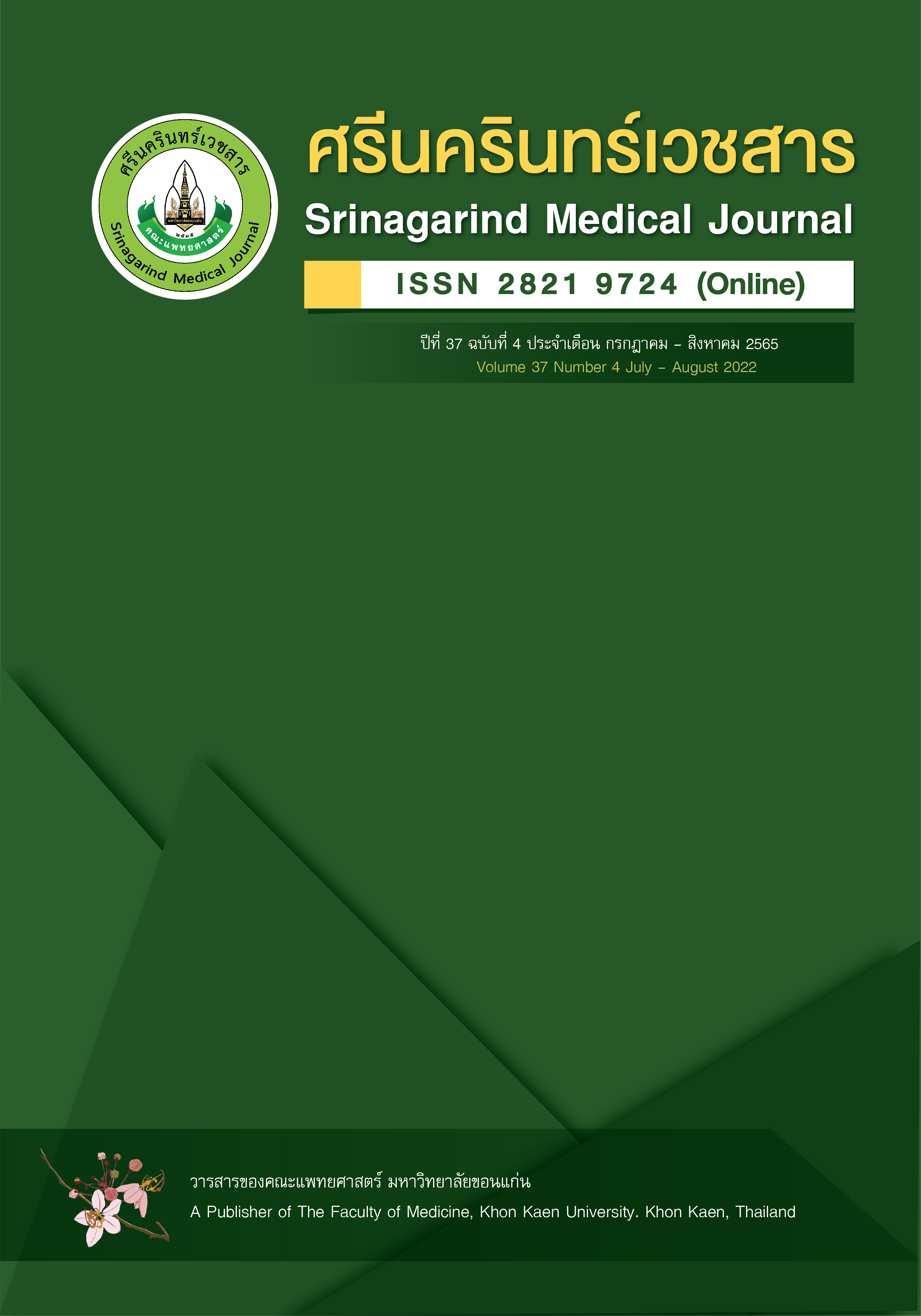ปัญหาการเข้ารับบริการของผู้ป่วยปากแหว่ง เพดานโหว่
Abstract
ปัญหาการเข้ารับบริการของผู้ป่วยปากแหว่ง เพดานโหว่
ยุพิน ปักกะสังข์1, สุธีรา ประดับวงษ์2*, ชิโนรส ปิยกุลมาลา2, อารยา ภิเศก3
1 แผนกการพยาบาลศัลยกรรมและออร์โธปิดิกส์ งานบริการพยาบาล โรงพยาบาลศรีนครินทร์ คณะแพทยศาสตร์ มหาวิทยาลัยขอนแก่น
2 ศูนย์วิจัยผู้ป่วยปากแหว่งเพดานโหว่ และความพิการแต่กำเนิดของศีรษะและใบหน้า มหาวิทยาลัยขอนแก่น
3 แขนงวิชาทันตสาธารณสุข สาขาวิชาทันตกรรมป้องกัน คณะทันตแพทยศาสตร์ มหาวิทยาลัยขอนแก่น
Problems with Access to Services for Orofacial Clefts Patients
Yupin Paggasang1, Suteera Pradubwong2*, Chinorose Piyakulmala2, Araya Pisek3
1 Department of Surgery, Division of Nursing, Srinagarind Hospital, Faculty of Medicine, Khon Kaen University
2 Research Center of Cleft Lip - Palate and Craniofacial Deformities, Khon Kaen University
3 Division of Dental Public Health, Department of Preventive Dentistry, Faculty of Dentistry, Khon Kaen University
Received: 25 January 2022 / Revised: 13 June 2022 / Accepted: 8 July 2022
*Corresponding author: Suteera Pradubwong, E-mail: p-suteera@hotmail.com
หลักการและวัตถุประสงค์: ภาวะปากแหว่ง เพดานโหว่ มีการจัดบริการเป็นทีมสหสาขาที่มีความยุ่งยากซับซ้อน การค้นหาปัญหาการเข้ารับบริการของผู้ป่วยจึงมีความสำคัญ
วิธีการศึกษา: เป็นการศึกษาเชิงพรรณนาในการค้นหาปัญหาการเข้ารับบริการของผู้ป่วยปากแหว่ง เพดานโหว่ ในคลินิคบูรณาการ จากกลุ่มตัวอย่าง 120 ราย ใช้แบบสอบถามที่พัฒนาขึ้น คือ 1) ข้อมูลทั่วไป 13 ข้อ 2) ปัญหาก่อนและระหว่างมารับบริการ 33 ข้อ และ 3) ปัญหาอื่น ๆ ใช้เวลาในการตอบ 15 นาที วิเคราะห์ข้อมูลเชิงปริมาณใช้สถิติร้อยละ เชิงคุณภาพสรุปและวิเคราะห์
ผลการศึกษา : ผู้ป่วยส่วนใหญ่เป็นเพศชาย อายุ 0-5 ปี และใช้สิทธิการรักษาบัตรประกันสุขภาพถ้วนหน้า ร้อยละ 55, 34.2, 79.2 ตามลำดับ ผู้ปกครองส่วนใหญ่เป็นเพศหญิง อายุ 41-50 ปี จบมัธยมศึกษา และได้รับความช่วยเหลือจากมูลนิธิตะวันฉายฯ ร้อยละ 82.5, 33.9, 35.8 และ 66.7 ตามลำดับ ปัญหาก่อนเข้ารับบริการ คือ สถานที่รักษาอยู่ไกลจากบ้าน และไม่ทราบว่ามีหน่วยงานช่วยเหลือร้อยละ 42.5 และ 32.5 ปัญหาระหว่างมารับบริการ คือ ไม่มีค่าเดินทาง ที่จอดรถไม่เพียงพอ และใช้เวลารอรับบริการนาน ร้อยละ 25.8, 23.3 และ 12.5 ตามลำดับ
สรุป: ปัญหาการเข้ารับบริการ คือ สถานที่รักษาอยู่ไกลจากบ้าน ไม่มีค่าเดินทาง ใช้เวลารอรับบริการนานและที่จอดรถไม่เพียงพอ หน่วยงานต้องพัฒนาและบริหารจัดการการให้บริการที่รวดเร็ว และสนับสนุนค่าเดินทางในการติดตามการรักษาอย่างต่อเนื่อง
คำสำคัญ: การเข้ารับบริการ ปากแหว่ง เพดานโหว่ ศูนย์ตะวันฉาย
Background and Objectives: Cleft lip and Cleft Palate are handled by a complex multidisciplinary team, therefore, identifying the patients’ problems regarding the accessibility of services is important.
Methods: A descriptive study on finding problems in accessing services in an integrative clinic of patients with an Orofacial Cleft from a sample of 120. A questionnaire developed were used: 1) 13 general data, 2) 33 problems before and during the service, and 3) other problems. Giving each patient/caregiver a response time of 15 minutes. Quantitative data were analyzed using percentage statistics, and content analysis were qualitative data.
Results: Most of the patients were male, aged 0-5 years, and had the right to Thailand’s universal health coverage at 55%, 34.2, and 79.2, respectively. Most of the parents were female, aged 41-50 years, completed secondary education and received assistance from the Tawanchai Foundation, 82.5%, 33.9, 35.8, and 66.7, respectively. 42.5% said the problem they had before receiving the service was the treatment location was far from home. And 32.5% didn’t know Tawanchai Center existed. The problems they faced during the service are they do not have enough money to travel. Not enough parking and had to wait for longtime in order to receive the services and treatments, these problems made up 25.8%, 23.3%, and 12.5%, respectively.
Conclusion: The problem with receiving services is that the treatment facility is far from home, the patients and their caregivers don’t have money to travel to the center, a long waiting time, and insufficient parking space. The center must develop and manage a fast service, and support the travel expenses for continuous follow-up treatment.
Key words: Accessibility, Orofacial Cleft and Craniofacial Deformities by Birth, Tawanchai Center


